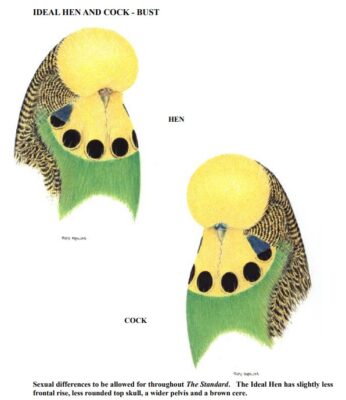Australian National Budgerigar Council
Exhibition Budgerigars & The Standard of Perfection
You can view the current ANBC standard here – 2025 ANBC Standard
You can find the ANBC Standard Pictorial Presentation
The Standard of Perfection defines what is an exhibition budgerigar. Their distinctive markings, vibrant colors, and impressive feather patterns are what Budgerigars are known for. This popularity makes them a common choice as the world’s third most popular pet. In addition, they are hugely popular in bird shows and exhibitions around the world. However, budgerigars are not all created equal. They have changed significantly from wild budgerigars to the exhibition budgerigars we see today. To ensure that the birds exhibited at these shows meet a certain standard of excellence, there are strict guidelines and criteria that must be met. The ANBC is the custodian of the Standard of Excellence for Australia, and across the world, there is the World Budgerigar Organisation, or WBO.
Having a standard of excellence ensures that the birds exhibited are of the highest quality. This is important for the integrity of the show and the reputation of the breeders. By adhering to strict guidelines and criteria, breeders can ensure that the birds they are exhibiting are healthy, well-fed, and free from abnormalities. Secondly, having a standard of excellence promotes healthy competition among breeders. A standard of perfection to aspire for motivates breeders to produce the best possible birds. This in turn can lead to better overall breeding practices and improved bird health. Thirdly, this guideline also helps to preserve the breed and more specifically, the variety. Competitive breeding encourages fanciers to diversify their breeding stock, thus improving genetic diversity. Lastly, having a standard of excellence helps to educate the public about the breed and its characteristics.

The Preservation of Varieties
Exhibiting birds that meet a certain standard can help people learn about the breed, its history, and unique characteristics. This can promote the breed and encourage more interest in it. A standard of excellence is crucial for ensuring the quality and health of exhibited budgerigars, promoting healthy competition among breeders, preserving variety, and educating the public. Adhering to guidelines and criteria can help ensure the long-term viability and popularity of each budgerigar variety in the world of bird shows and exhibitions.
Understanding The Matrix
The process of writing the current Standard was long and thought-provoking. To ensure that the final document was of high quality and easily understood by all, the issuing authorities finally issued it in 1990. The resultant overall document was simplistic and concise and in a much more readable form than any other Standard throughout the world, yet all information was included.
Key features appeared in this material that is unique to Australians reading and understanding this written word. To fully understand the document in its entirety one needs to link the various parts to achieve a full understanding. i.e. The photo plates link to the written word to give us dimension.
The matrix that Gordon Lowe of South Australia developed initially is a key feature that deserves further explanation. Gordon, as well as being a prominent budgerigar breeder and judge, had had a long involvement in the chicken industry and his knowledge of chicken varieties was a key to the matrix and how it evolved.
Studying the matrix provides a complete and accurate placement level of all varietal combinations that the primary varieties currently recognize. Reading the matrix in an ascending order displays the primary varieties for placing birds in shows, providing Australians with a consistent approach to class placement.

More About The Matrix
The matrix truly covers all varietal combinations for the varieties in a concise and accurate format and the concept is one of brilliance and a great asset to the overall document. Given its simplicity, everyone can easily understand it as it quickly covers these combinations. These accepted combinations also determine the placement of the variety in the matrix.
The content excludes certain color combinations for good reason. Some are not allowable, while others are left blank, indicating their impossibility. As examples why is there not a combinations of Dominant Pied Clearwings or Fallow Cinnamons. The answer lies in the visual combinations. These combinations are alike to other birds or are undistinguishable from these other combinations. How could a judge or in fact a breeder correctly determine these combinations without accurate genetic material?
We should all pay homage to the matrix as a unique and Australian-owned piece of conceptual thought put on paper.
